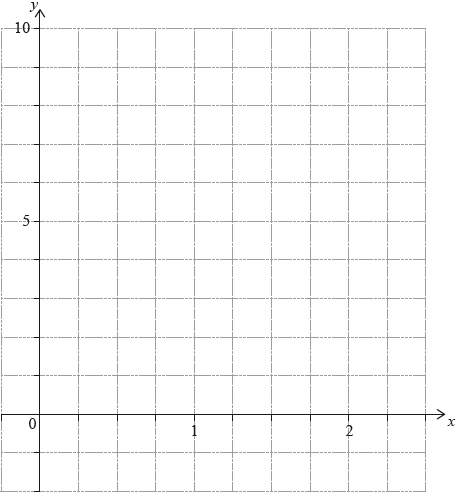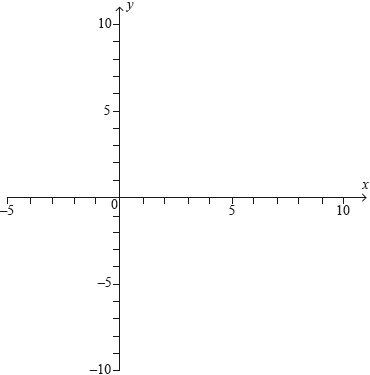| Date | November 2021 | Marks available | 3 | Reference code | 21N.1.SL.TZ0.5 |
| Level | Standard Level | Paper | Paper 1 | Time zone | Time zone 0 |
| Command term | Find | Question number | 5 | Adapted from | N/A |
Question
Let the function represent the height in centimetres of a cylindrical tin can with diameter .
for .
The function is the inverse function of .
Find the range of .
Find .
In the context of the question, interpret your answer to part (b)(i).
Write down the range of .
Markscheme
OR (M1)
Note: Award (M1) for substituting or into . This can be implicit from seeing or .
A1A1
Note: Award A1 for both correct endpoints seen, A1 for the endpoints in a correct interval.
[3 marks]
OR OR (M1)
A1
[2 marks]
a tin that is high will have a diameter of A1
Note: Condone a correct answer expressed as the converse.
[1 mark]
A1
Note: Accept . Do not FT in this part.
[1 mark]
Examiners report
Part (a) was reasonably well done. Many candidates were able to find the endpoints but there was some confusion about whether to use strict or weak inequalities. Some candidates wrote their answer as while some others wrote . A few candidates used integer values from to to find corresponding values for and gave the full list as their final answer. In part (b), the most popular incorrect answer seen was with weaker candidates simply finding . Several candidates equated to but missed out in their equation. Finding a value of the inverse of a function still proves to be difficult for candidates. There were many candidates who attempted to find an expression for the inverse before substituting by and this proved to be difficult for this function. Regardless of what answer candidates derived for part (b), very few of them could write an interpretation of their answer in context. There was significant confusion between the value for the height and value for the diameter. In part (d), there were very few candidates who realized the relationship between the domain of the function and the range of the inverse function. Many candidates simply reverted to their answer to part (a).
Part (a) was reasonably well done. Many candidates were able to find the endpoints but there was some confusion about whether to use strict or weak inequalities. Some candidates wrote their answer as while some others wrote . A few candidates used integer values from to to find corresponding values for and gave the full list as their final answer. In part (b), the most popular incorrect answer seen was with weaker candidates simply finding . Several candidates equated to but missed out in their equation. Finding a value of the inverse of a function still proves to be difficult for candidates. There were many candidates who attempted to find an expression for the inverse before substituting by and this proved to be difficult for this function. Regardless of what answer candidates derived for part (b), very few of them could write an interpretation of their answer in context. There was significant confusion between the value for the height and value for the diameter. In part (d), there were very few candidates who realized the relationship between the domain of the function and the range of the inverse function. Many candidates simply reverted to their answer to part (a).
Part (a) was reasonably well done. Many candidates were able to find the endpoints but there was some confusion about whether to use strict or weak inequalities. Some candidates wrote their answer as while some others wrote . A few candidates used integer values from to to find corresponding values for and gave the full list as their final answer. In part (b), the most popular incorrect answer seen was with weaker candidates simply finding . Several candidates equated to but missed out in their equation. Finding a value of the inverse of a function still proves to be difficult for candidates. There were many candidates who attempted to find an expression for the inverse before substituting by and this proved to be difficult for this function. Regardless of what answer candidates derived for part (b), very few of them could write an interpretation of their answer in context. There was significant confusion between the value for the height and value for the diameter. In part (d), there were very few candidates who realized the relationship between the domain of the function and the range of the inverse function. Many candidates simply reverted to their answer to part (a).
Part (a) was reasonably well done. Many candidates were able to find the endpoints but there was some confusion about whether to use strict or weak inequalities. Some candidates wrote their answer as while some others wrote . A few candidates used integer values from to to find corresponding values for and gave the full list as their final answer. In part (b), the most popular incorrect answer seen was with weaker candidates simply finding . Several candidates equated to but missed out in their equation. Finding a value of the inverse of a function still proves to be difficult for candidates. There were many candidates who attempted to find an expression for the inverse before substituting by and this proved to be difficult for this function. Regardless of what answer candidates derived for part (b), very few of them could write an interpretation of their answer in context. There was significant confusion between the value for the height and value for the diameter. In part (d), there were very few candidates who realized the relationship between the domain of the function and the range of the inverse function. Many candidates simply reverted to their answer to part (a).



